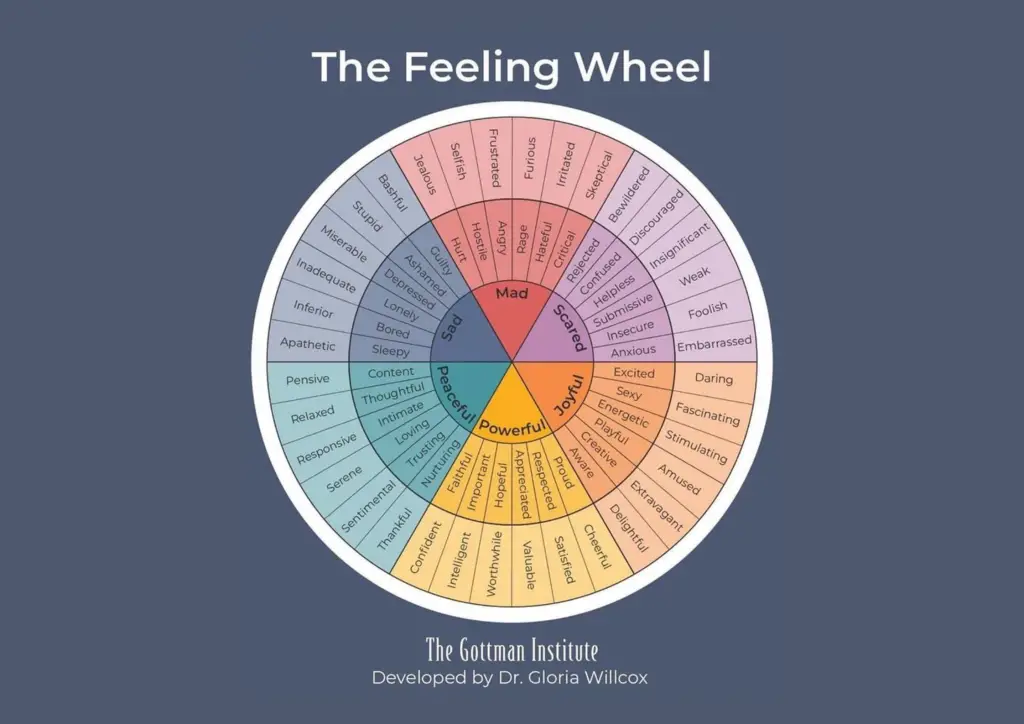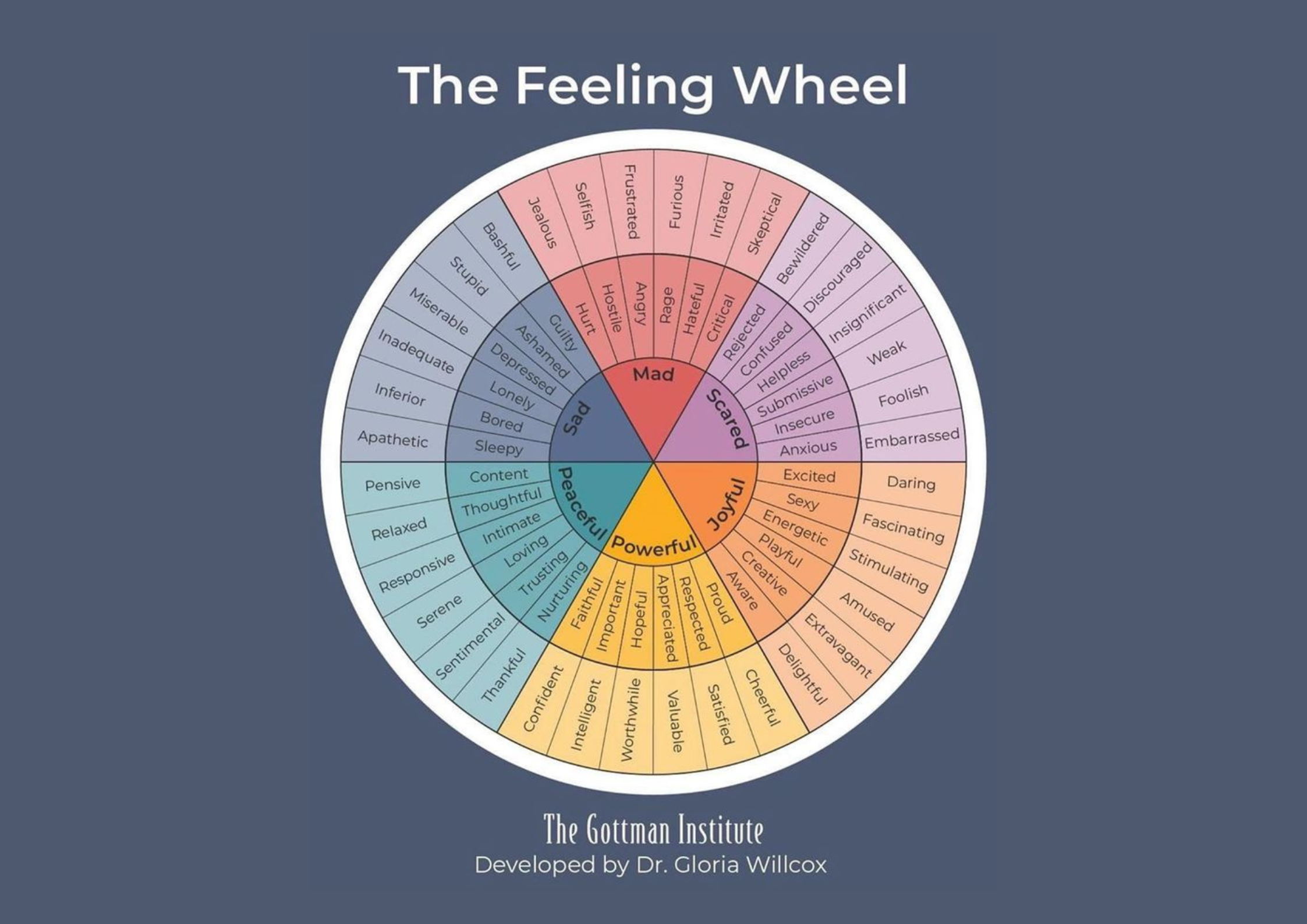Emotion Wheel Chart: Understanding and Using the Tool for Emotional Intelligence

Many people start losing touch with their emotions from a young age. This could be due to traumatic experiences from which the psyche starts to suppress emotions, an invalidating environment with messaging such as “you’re being sensitive” and “don’t be so dramatic”, or a lack of emotional education from one’s parents. Regardless of the cause, being disconnected from emotions comes at a high cost for one’s own well-being and emotional regulation, as well as for the health of relationships with others. We need awareness of our emotions and a rich language to describe them to manage our emotionally charged behaviors, self-talk, and interactions with others. The emotion wheel is one tool that can help us re-learn the contours of our inner emotional landscape.
Emotion Wheel Chart: Understanding and Using the Tool for Emotional Intelligence

How to Understand Your Emotions?
The Spectrum of Emotions
Emotions are an essential part of human life. They are complex and can be difficult to understand, but even more so if we do not have the vocabulary to capture them accurately. Best-selling author, professor, and researcher Dr. Brene Brown surveyed over seven thousand people to list all the emotions they could recognize and name as they were experiencing them. The average number? Three: happy, sad, and angry.
Of course, humans experience a far greater range of emotions than just happy, sad, and angry! We experience shame, overwhelm, disgust, boredom, surprise, and innumerable others, but I remember a time when I couldn’t list more than a handful. My family wasn’t the type to talk about feelings, and we were encouraged to “be happy.”
Not only do we have lots of feelings, but we can experience them to different degrees or depths. Sadness can span from feeling bummed to feeling disappointed to feeling grief-stricken. As a child, I would have probably called all those ‘sad’ or ‘upset’ not knowing there were words that could capture exactly how I felt.
A language that addresses the nuances in the range and depth of emotions is critical for understanding our experiences, connecting to others, and meeting our needs. Emotion wheels attempt to give us this language by visually grouping and organizing emotions to represent the relationships between them.
Identifying and Naming Emotions
Identifying emotions and ascribing them to a proper name is often the first step in emotional regulation. In other words, when a feeling is named, it is tamed. There is ample research to support this: simply by putting words to a feeling, the body and emotional circuits start to regulate or return to baseline.
My first experience with the power of naming emotions to help tame them was in my early twenties. I was in a period of my life where I generally felt really low- I had little energy and motivation, my mood was persistently low, and I was prone to bouts of crying without understanding why. I worked with a therapist who suggested that I get really curious and specific about what I was feeling in those moments. Then, she told me, I could imagine setting each emotion on a leaf that could sit near me or drift away at any point. It only took a few times trying this exercise to realize that naming my emotions helped me feel like I had more control over them. It had far less to do with imagining them on the leaf (although I liked that part too!) and was more about recognizing what was happening inside myself.

It is rare for humans to experience just one emotion at a time, which is where the complexity of identifying emotions increases. It would be simpler if there were only one ‘answer’ to come up with. However, one or more primary and many secondary emotions are typically experienced simultaneously. Primary emotions are the first emotional reactions to a given stimulus, either internal or external. These responses are natural and instinctive and typically involve core emotions. Secondary emotions are emotional reactions that are felt after the primary emotion. These responses tend to be learned or conditioned and are impacted based on culture and other personal factors. For example, in my story the primary emotion was sadness, and the secondary emotions I felt in response were shame, embarrassment, confusion, hopelessness, and sometimes anger. Putting all of this together was incredibly helpful in reducing the intensity of my experience!
Naming primary and secondary emotions gives a sense of control over the emotional experience. These feelings can then be expressed to someone else to increase connection, gain support, or communicate a need. If identifying emotions feels like a daunting task, this is where an emotion wheel can come in handy!
The Basics of Emotion Wheel Charts
What Is an Emotion Wheel?
An emotion wheel is a circular diagram that visually represents the range of emotions humans experience. It is a tool for identifying and labeling emotions and understanding how different emotions are related to one another. The emotion wheel is typically divided into several sections, each representing a different category of emotions.
Different Types of Emotion Wheels
Several versions of emotion wheels have been developed over the years. Dr. Robert Plutchik created his original model in 1980, and since then other researchers have created variations incorporating additional emotions or different ways of representing emotions.

The emotion wheel created by Dr. Plutchik consists of eight so-called ‘primary’ emotions that are divided into concentric circles to display both intensity and polarity. Similarly to colors on a color wheel, the intensity of emotions is distinguished by the saturation of the color, and opposite emotions are distinguished by complementary colors. Take, for example, the primary emotion of joy. On this wheel, joy is divided into subsets of serenity (pale yellow, on the low end of the intensity spectrum) and ecstasy (deep yellow, on the high end of the intensity spectrum). Sadness, the opposite of joy, is represented in varying shades of purple, which is the color opposite yellow on the color wheel.

A Swiss psychologist developed the Geneva Emotion Wheel as an alternative to Plutchik’s model. The Geneva Wheel differentiates four categories of emotion and thus divides the wheel into four quadrants. Emotions are grouped based on whether they are pleasant or unpleasant and whether one has high or low control over them.

The Junto emotion wheel is another alternative that has become a popular visual in many therapist offices. This visual depicts six core emotions at the center of the circle, each radiating into increasingly specific emotions from the more general core emotion. Shades of the same color represent each category to help visually differentiate the types of emotions.
It does not matter which version of the emotion wheel one uses. All emotion wheels are simply tools to help the user better understand emotions and how they relate to each other.
How to Use the Emotion Wheel Chart?
To use an emotion wheel, one must first understand some primary emotions and know how they manifest. Knowing how an emotion feels in the body is a great entry point. For instance, does anger feel like pressure in the chest, heat rising in the cheeks, or an urge to shout? If so, experiencing sensations similar to these would indicate that one is feeling angry, or something similar. Look at the emotion wheel to see what emotions are related to anger and if something more specific is being felt: frustration, resentment, contempt, etc.
Practical Applications
The emotion wheel chart can be used in a variety of practical applications. Individuals can use it to identify and understand their emotions, couples to improve communication and understanding, and therapists to help clients explore and process their emotions.
The emotion wheel chart can help individuals identify and label their emotions. I often used this tool when I first started therapy and was learning about the differences in emotions. It helped me feel like I understood myself better and helped me communicate my experience to others so they could understand me better, too.
For couples, the emotion wheel chart can be used to improve communication and understanding. By identifying and sharing their emotions with each other, couples can build empathy and strengthen their relationship. Knowing if a partner feels overwhelmed versus dread, annoyance versus resentment, disappointment versus devastation makes a big difference. When one understands more accurately what is happening with the other person, it is easier to respond empathetically.
Therapists can use the emotion wheel chart to help clients explore and process their emotions. The chart can help clients identify and label their emotions, which can be an important step in the therapeutic process.
Steps to Effectively Use an Emotion Wheel

To effectively use an emotion wheel, follow these steps:
- Identify your emotion: Look at the emotion wheel chart and identify the emotion that best describes your feelings. If you are unsure, check in with familiar responses in the body that may indicate a particular feeling.
- Label the emotion: Once you have identified the emotion, label it. This can be done by saying the emotion out loud, writing it down, or even naming it in your head.
- Identify the intensity of the emotion: Use the intensity scale on the emotion wheel chart to determine the intensity of the emotion.
- Identify the underlying emotions: Use the emotion wheel chart to identify any underlying emotions contributing to or responding to the primary emotion.
By following these steps, individuals can use an emotion wheel chart to identify and understand their emotions.
Benefits of Incorporating Emotion Wheels
Understanding and managing emotions is an important aspect of mental health and well-being. Emotion wheels are a valuable tool to help individuals identify and process emotions effectively. Here are some benefits of incorporating emotion wheels into your daily life:
Improved Emotional Intelligence
One of the primary benefits of using an emotion wheel is that it can help individuals develop their emotional intelligence. Emotional intelligence is the ability to identify, understand, and manage one’s emotions and those of others. By using an emotion wheel, individuals can become more aware of their emotions and learn how to regulate them effectively. This can lead to better decision-making, improved communication skills, and positive interpersonal relationships.
Stress Reduction and Promotes Mental Wellness
An emotion wheel can also help individuals manage stress and promote mental wellness. When individuals are able to identify and process their emotions effectively, they are less likely to experience negative emotions such as anxiety and depression. This can lead to a greater sense of well-being and an overall improvement in mental health.
Enhancing Interpersonal Relationships
Another benefit of incorporating emotion wheels into your daily life is that it can help enhance interpersonal relationships. By becoming more aware of your emotions and regulating them effectively, you can improve your communication skills and develop stronger, more positive relationships with others. This can lead to a greater sense of connection and belonging, which is important for overall well-being.
Additional Benefits
In addition to the benefits listed above, using an emotion wheel can also help individuals:
- Develop greater self-awareness
- Improve decision-making skills
- Enhance empathy and compassion towards others
- Strengthen problem-solving abilities
Incorporating an emotion wheel into your daily life can positively impact your mental health and well-being. By becoming more aware of your emotions and learning to regulate them effectively, you can improve your relationships, reduce stress, and enhance your overall well-being.
DIY: Creating Your Emotion Wheel Chart

Materials Needed
To create an emotion wheel chart, one will need a few materials. These materials include:
- A blank piece of paper or cardstock
- A compass or round object to trace
- A ruler
- Markers or colored pencils
Step-by-Step Guide
- First, take the blank piece of paper or cardstock and use the compass or round object to trace a circle in the center of the page. This will serve as the base of the emotion wheel chart.
- Next, use the ruler to divide the circle into eight equal sections. Draw lines from the center of the circle to its circumference.
- Label each section with a primary emotion: joy, trust, fear, surprise, sadness, anticipation, anger, and disgust. These eight primary emotions are the basis for the emotion wheel chart.
- Once the primary emotions are labeled, divide each section into smaller sections representing the secondary emotions associated with each primary emotion. For example, one might list secondary emotions such as contentment, happiness, and love under the primary emotion of joy.
- Finally, use markers or colored pencils to fill each section with the appropriate color and label each secondary emotion with its corresponding color.
- Optional: What to take it a step further? Add a section for physical sensations that coincide with each emotion! This is the ultimate way to customize the wheel and increase awareness of self!
Creating an emotion wheel chart can be a fun, creative, and therapeutic way to explore and understand one’s emotions. By following these simple steps and using materials that are likely already around the house, anyone can create an emotion wheel chart to help them better understand their emotions and how they relate to one another.
Tips for Choosing the Right Emotion Wheel
Here are some tips to consider when choosing the right emotion wheel chart:
Considering Personal Preferences
Various types of emotion wheel charts are available, and choosing one that resonates with personal preferences is essential. Some charts are color-coded, while others may have different shapes or sizes. Some individuals may prefer a chart with more detailed descriptions of emotions, while others prefer a simpler one. Find a chart that aligns with personal preferences to make the process of recognizing and understanding emotions more effective.
Compatibility with Individual Needs
Compassion with individual needs is another crucial factor when choosing an emotion wheel chart. For instance, some charts may be more suitable for children, while others may be more appropriate for adults. Additionally, some charts may be more effective in a therapeutic setting, while others may be more beneficial for personal use. Consider individual needs when choosing an emotion wheel chart to ensure it effectively achieves the desired goals.
Takeaways
Recap of Key Points
An emotion wheel chart is a visual tool that helps individuals identify emotions as a first step toward increased personal awareness and emotional regulation. Typically, a wheel consists of basic and related emotions that are more specific and vary in intensity.
The emotion wheel can be used to identify emotions, determine the intensity of emotions, and understand the relationships between emotions. Individuals can better understand themselves using the emotion wheel, improving emotional regulation and communication.
Encouragement for Readers to Start Exploring Emotion Wheels
If you are interested in exploring the emotion wheel chart, there are many resources available online to help you get started. You can find free emotion wheel charts on PositivePsychology.com and Psych Central. These resources can help you identify and work through your emotions, improving your emotional well-being.
You can also reach out to start work with an individual therapist who will be trained to help you navigate your inner emotional landscape using tools like an emotion wheel and various other tools and treatment modalities to deepen the work. Whether you have the emotional understanding and vocabulary of a beginner or a seasoned pro, brushing up on skills to understand yourself and your emotions better never hurts.

About the Author:
Victoria Brandt, LAC.

Victoria is an LAC at Infinite Healing & Wellness. She works with clients across the lifespan to help them reprocess trauma and better cope with life’s challenges. Victoria is in the process of being certified in EMDR and leads emotional skills groups for teenagers and their parents.
Frequently Asked Questions
What is an emotion wheel?
An emotion wheel is a circular diagram that visually represents the range of emotions humans experience. It helps identify and label emotions and understand how different emotions are related to one another.
How do emotion wheels help in understanding emotions?
Emotion wheels visually group and organize emotions to represent the relationships between them. They provide a language that addresses the nuances in the range and depth of emotions, making it easier for individuals to understand their experiences and connect with others.
Why is identifying and naming emotions important?
Identifying and naming emotions is often the first step in emotional regulation. By putting words to a feeling, the body and emotional circuits start to regulate or return to baseline. This process helps individuals gain a sense of control over their emotional experiences.
How do primary and secondary emotions differ?
Primary emotions are the first emotional reactions to a given stimulus, either internal or external. They are natural and instinctive and typically involve core emotions. Secondary emotions, on the other hand, are emotional reactions felt after the primary emotion. These responses tend to be learned or conditioned and are influenced by culture and other personal factors.
What are some practical applications of emotion wheel charts?
Emotion wheel charts can be used by individuals to identify and understand their emotions, couples to improve communication and understanding, and therapists to help clients explore and process their emotions.
How can individuals effectively use an emotion wheel chart?
To effectively use an emotion wheel chart, individuals can follow these steps:
Identify the emotion, label the emotion, determine the intensity of the emotion, identify any underlying emotions contributing to or responding to the primary emotion.
What are the benefits of incorporating emotion wheels into daily life?
Some benefits of using emotion wheels include Improved emotional intelligence, stress reduction and promotion of mental wellness, enhanced interpersonal relationships, greater self-awareness, improved decision-making skills, enhanced empathy and compassion towards others, strengthened problem-solving abilities.
How can individuals create their own emotion wheel chart?
To create an emotion wheel chart, individuals will need a few materials such as a blank piece of paper or cardstock, a compass or round object to trace, a ruler, and markers or colored pencils. They can then follow a step-by-step guide to create their own customized emotion wheel chart.
How should one choose the right emotion wheel chart?
When choosing the right emotion wheel chart, personal preferences and compatibility with individual needs must be considered. Various types of emotion wheel charts are available, and individuals should choose one that resonates with their preferences and effectively achieves their desired goals.
Where can individuals find resources to explore emotion wheels further?
Individuals interested in exploring emotion wheel charts can find free resources online on websites such as PositivePsychology.com and Psych Central. These resources can help them identify and work through their emotions, improving their emotional well-being. Individuals can also work with therapists trained to help them navigate their inner emotional landscape using tools like an emotion wheel and various other treatment modalities.








